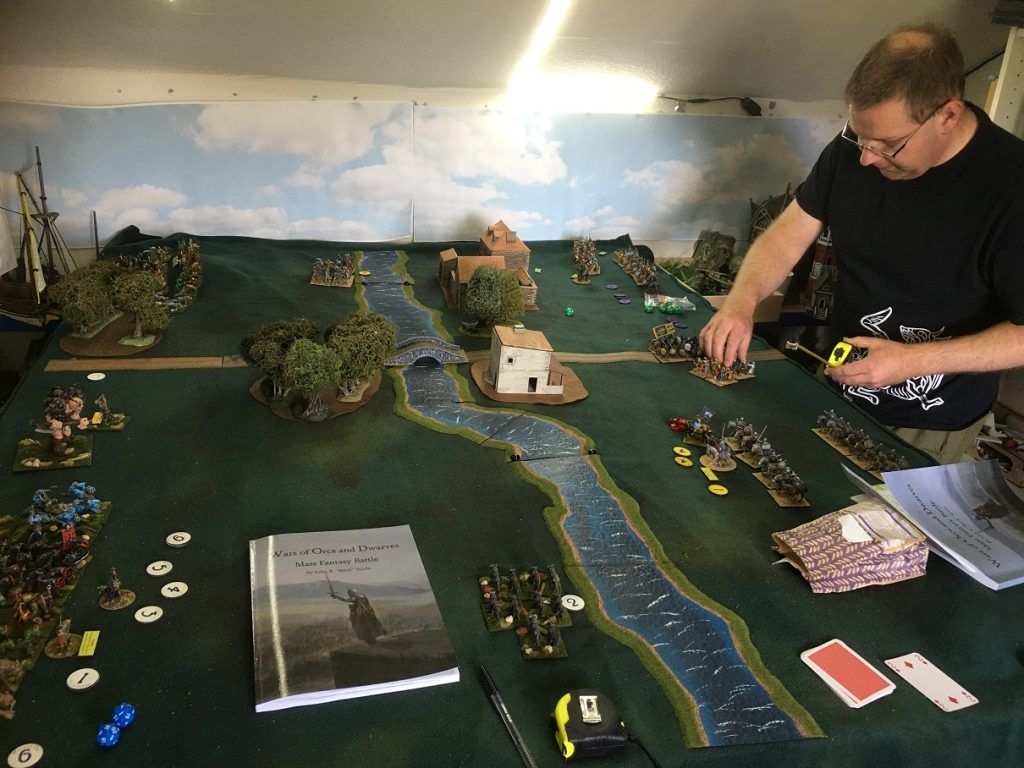
Last Wednesday Mike and I got together to play War of Orcs and Dwarves. Wars of Orcs and Dwarves is a mass Fantasy Battle Game. What we mean by this is that it is a game where unit represent several hundred troops and are represented by multiple bases (normally 4-6) covered with miniatures. Units are part of Brigades and Brigades are part of an Army.
I am fielding an army or Orcs strengthened by a huge giant. Mike is fielding a human army with an Eastern theme. His army has been selected from the ‘Empires of Man’ sample army list and his units are made from Gripping Beast plastic Arab Infantry & Cavalry. My Orcs come from many sources including the very first plastic Orcs from Games Workshop Warhammer Fantasy Battle, and metal miniatures from Scotia Grendel, Alternative Armies , Old Glory and Sally 4th.

We each fielded around 800 points worth of troops, split into two brigades. The terrain featured a river flowing North to South along the centre of the table, bisected by a road running East to West. Where the road crossed the river there was a substantial stone bridge, of strategic importance. The mission of each armies commander was to seize the bridge and hold it until the end of the game. The river was fordable, but not within 50 cm North or South of the bridge. Mike deployed one brigade on the Northern table edge, east of the river and the second brigade on the eastern edge where the road entered the table. My brigades were to enter on the western table edge where the road entered the table and on the southern table edge to the west of the river. Unfortunately my brigade entering on the road was delayed until the start of the second turn.

Units entered the table in column according to a predetermined order of march when the particular unit was activated (as long as there was room for them to deploy). Wars of Orcs and Dwarves uses a clever, two stage activation process. At the start of each turn the player checks which units are within the brigade commanders, command radius. A D6 is rolled for each of these units and a token or dice is added with this number on it to the particular commanders command pool. Units which are out of command because they are to far away have a separate D6 rolled for them and allocated straight away as they are to far away for the brigade commander to be able to influence them.
Mike explains how this all works in the following video:
War of Orcs and Dwarves uses an activation deck to determine the order in which units activate. The deck contains numbered playing cards 1-6 in both red and black together with two jokers. At the start of the game, one side is allocated ‘Red’ and the other ‘Black’. At the start of each turn, the cards are shuffled and the top card turned. Players who have activation tokens in there command pool that match that number may activate. The player chooses which unit or character they want to activate and place the command token on it. Out of command units with a matching token also activate at this time. If the card was black, the black player would go first, if it was red, the red player would activate first. When the two jokers have been revealed, the turn ends. In this way units might activate 0, 1 or 2 times in a turn.
In this next video Mike explains how unit activation works.

Armies are characterised by there doctrine as well as by the types of units that make up the army. Doctrines include Aggressive, Swarming, Deliberate, Determined, Mindless & Intelligent Undead. Each doctrine has it’s own quick reference chart. This is an A4 sheet, folded in half to A5. This sheet contains the attributes of the units plus all of the charts that are used to determine movement, shooting, melee and reaction tests. The charts are different for each army to reflect the armies fighting doctrine. For example, in this game my Orc Army is Aggressive (no surprises here they are Orcs after all), there reaction to being shot at is most likely going to be to charge the shooter… this represents there brutal and direct approach. They are more resilient than many types of armies reflecting there brutal nature. Most armies suffer a shift to the right, towards less favourable results on morale tests for each base they have lost as casualties, however an aggressive army only suffers a shift for the first and the third bases lost. This does not sound like a big deal, until you have played the game but does actually make the army a lot more resilient and more likely to continue fighting or fall back disordered rather than routing.
Mikes ‘Empire of Man’ army was characterised as deliberate. This reflects a more organised and subtle army whose reaction to being shot at is as likely to be to return fire and to enter an archery duel with an opponent.
In this next video Mike explains how shooting works in practice.
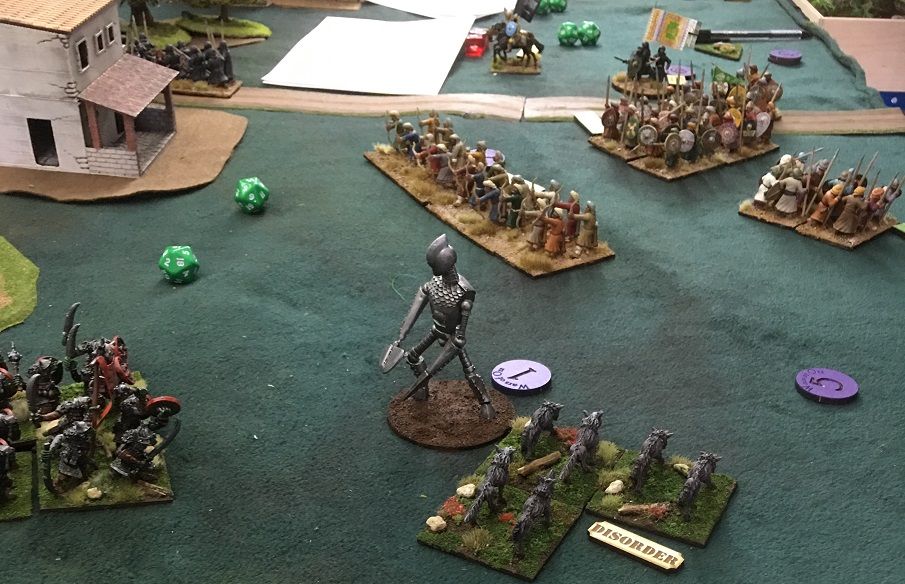
The Orc brigade advancing along the river bank decided to cross the river to engage the men on the other side. At this point the Wargs have charged and have fought a bitter melee with the spearmen who have routed, however the Wargs lost three bases in the melee and are now disordered.
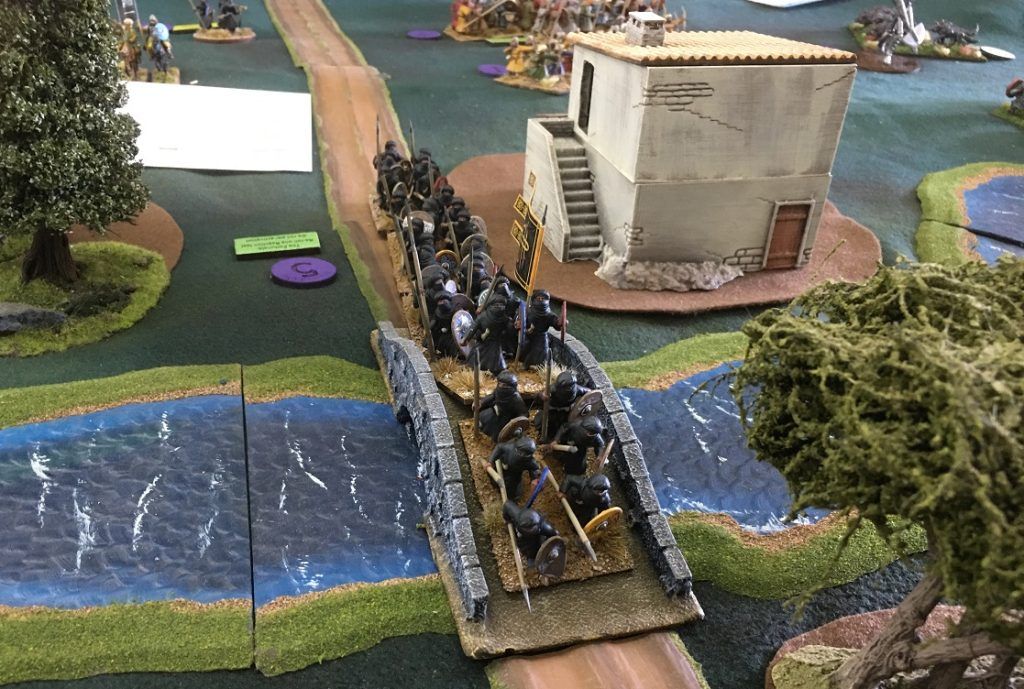
Mike has succeeded in deploying his elite black robed spearmen on to the contested bridge.
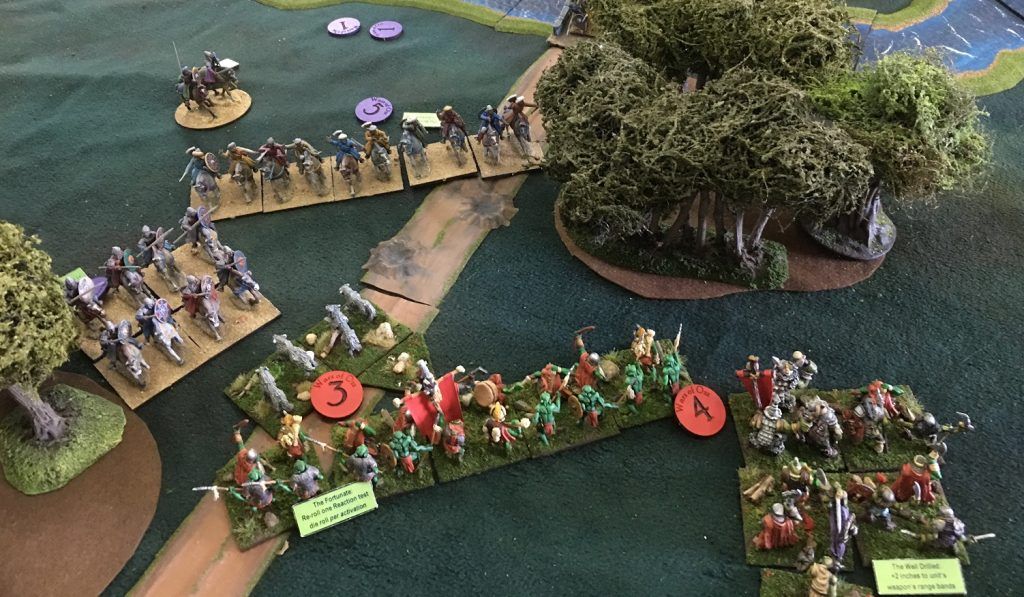
A number of fierce engagements are fought to the west of the bridge. The Orc army was disadvantaged by it’s late arrival and congested deployment zone between two heavily wooded areas. Although it holds it’s own against the constant attacks by the human knights they struggle to deploy the whole brigade and mount a co-ordinated counter attack.
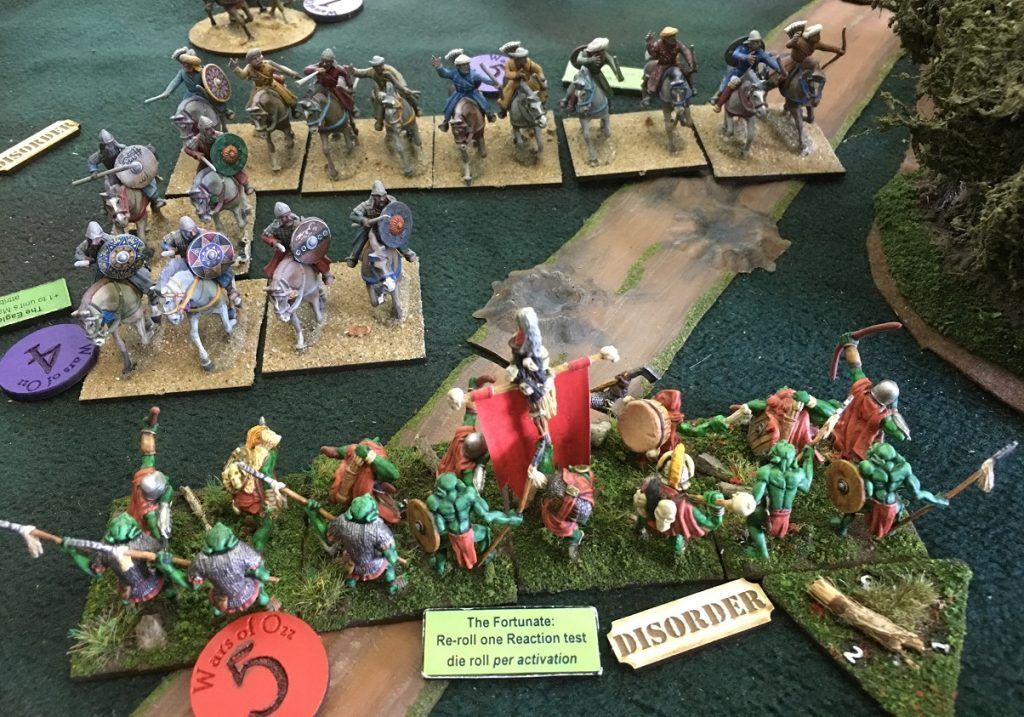
The first wave of knights has fallen back disordered after a brutal combat with the Orc Spearmen. The Knights lost two complete bases of troops (each base can take 4 casualties before being removed). The Orcs took 5 casualties that was enough for them to lose a base and one casualty to be carried forwards. The triangular marker shows how many ‘hits’ are left on a damaged base, in this case 3.
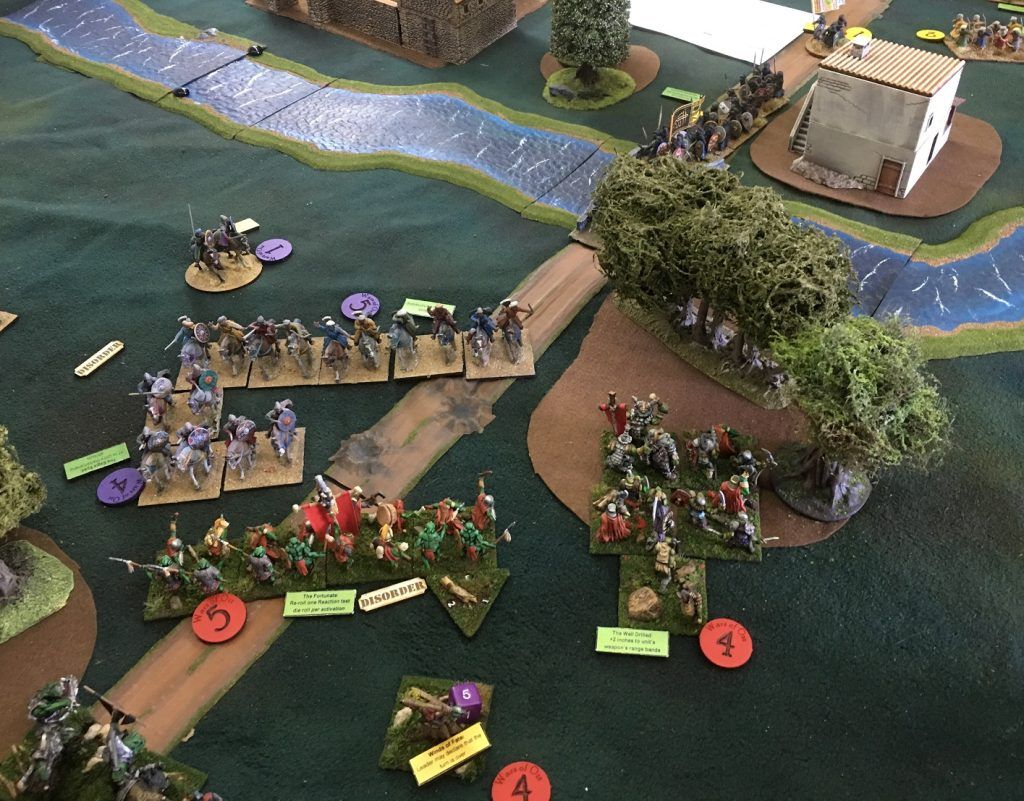
Another unit of Orcs pushes forward on there right flank but is slowed down by having to move through a wood (which reduces there speed to half).
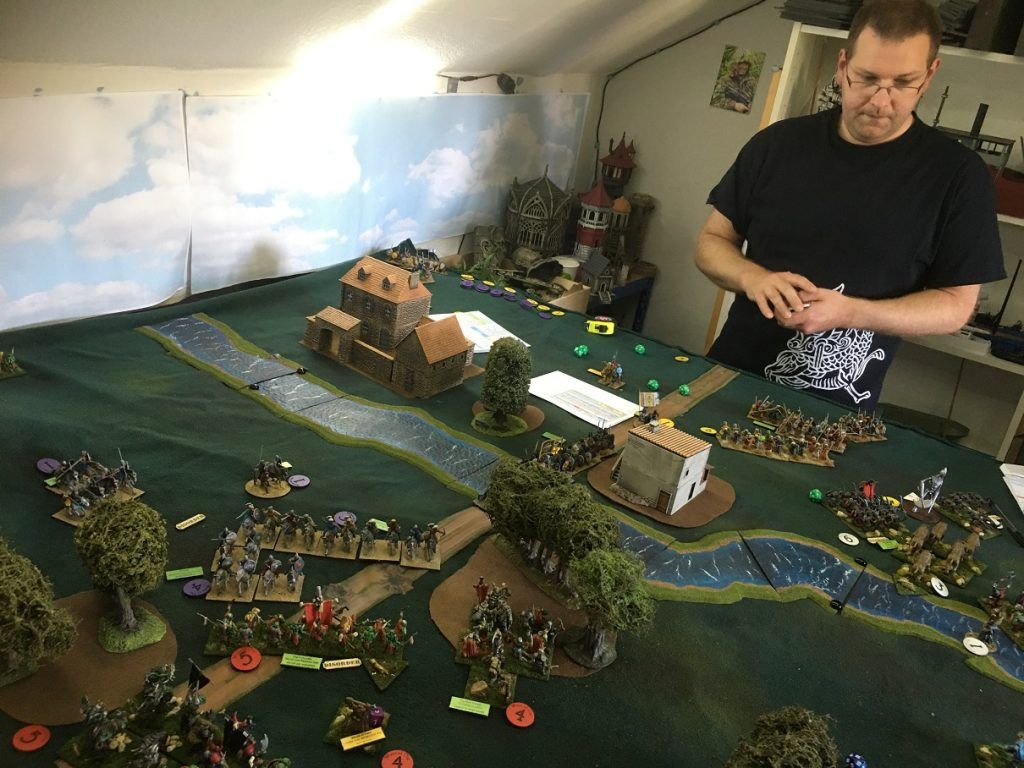
At the end of the game, which lasted six turns and was played to conclusion in three hours (including recording videos), Mike’s Empire Army was definitely in control of the bridge. Mike’s forces had performed well and he focussed from the start on taking the objective. The scenario (from a Charles Grant scenario book), was a lot of fun. It is always more challenging deploying from line of march rather than being able to start deployed in a battle line. I am looking forward to playing the game again, maybe with a more symmetrical terrain layout.
War of Orcs and Dwarves is a mass fantasy battle system which is miniatures and scale agnostic. It will cater for any fantasy army, in any scale, with what ever miniatures you have in your collection from any manufacturer.
It is available on Kickstarter until Tuesday 19th July, Click here to take a look.

0 Comments